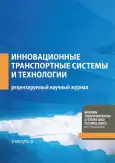Innovative technologies in the development of high-speed ground transport
- Authors: Kazanskaya L.F.1, Batalova N.V.1
-
Affiliations:
- Emperor Alexander I St. Petersburg State Transport University
- Issue: Vol 9, No 4 (2023)
- Pages: 108-116
- Section: Original studies
- URL: https://bakhtiniada.ru/transj/article/view/249980
- DOI: https://doi.org/10.17816/transsyst202394108-116
- ID: 249980
Cite item
Full Text
Abstract
Aim: is a comparative analysis of the technical and economic characteristics of various types of land rail transport.
Methods: comparative analysis, structuring of high-speed traffic processes, logical analysis of the cause-and-effect organization of the high-speed highways, made it possible to formalize the technical advantages of maglev transport technology in comparison with the construction of high-speed highways.
Results: A key trend has been identified to increase traffic speeds, requiring the convergence of various transport systems. The main criteria for innovative high-speed ground transport systems are classified. It is substantiated that increasing the level of technical characteristics of innovative technologies in the development of high-speed ground transport will allow maglev transport to become a key link in multimodal transport corridors. A comparison of the technical and economic characteristics of various types of land railway transport confirms that the introduction of MLTT into the transport complex will be able to significantly influence the matrix of the transport industry and accumulate both the passenger flow of air and rail traffic, as well as part of the containerized cargo, and become a key link in the multimodal transport corridors of the Russian Federation.
Conclusion: The conclusions are based on a representative sample of data on the innovative, technological and economic parameters of two high-speed rail construction technologies: wheel-rail and magnetic levitation.
Keywords
Full Text
##article.viewOnOriginalSite##About the authors
Liliya F. Kazanskaya
Emperor Alexander I St. Petersburg State Transport University
Author for correspondence.
Email: yalifa@inbox.ru
ORCID iD: 0000-0002-8734-1064
Doctor of Engineering Sciences, Professor
Russian Federation, St. PetersburgNatalia V. Batalova
Emperor Alexander I St. Petersburg State Transport University
Email: natalyabatalova@yandex.ru
ORCID iD: 0000-0002-5948-7226
Senior Lecturer
Russian Federation, St. PetersburgReferences
- Integrated transport system. Center for Strategic Development. Available on: https://www.csr.ru/upload/iblock/9f5/9f59e8789c4af88f7a67ce69c17d288e.pdf [cited 2023 Sep 20]. (In Russ).
- Kazanskaya L. Development of high-speed rail transport as a factor in increasing the competitiveness of the country's national economy. Economics and management in the 21st century: current issues, achievements and innovations. Penza; 2017. pp. 55-63. (In Russ.). The link is active on: 28.09.2023. Available from: https://elibrary.ru/item.asp?edn=ylsfgz
- Misharin A. Aspects of creating an integrated network of high-speed and high-speed communication in the Russian Federation. Transport of the Russian Federation. 2014;2(51):9-13. (In Russ). The link is active on: 28.09.2023. Available from: https://e-library.gumrf.ru/cgi
- Special technical conditions. Artificial structures on the site Moscow-Kazan high-speed railway Moscow-Kazan-Yekaterinburg. Technical standards and requirements for design and construction. (In Russ.). [cited 2023 Sep 20] Available from: https://www.rzd.ru/api/media/resources/c/1/121/72402?action=download
- China in the fast lane: bullet train and maglev. [Internet]. [cited 2023 Sep 20]. Available on: https://asiatimes.com/2018/08/china-in-the-fast-lane-bullet-trains-and-maglev-lines/
- Igolkin G. Prospects for the use of control automation systems in magnetic levitation transport technology. Technologies for constructing cognitive transport systems. Materials of the All-Russian Scientific and Practical Conference. May 30-31, 2018. St. Petersburg: IPT RAS, 2018, 278 p. (In Russ.). The link is active on: 28.09.2023. Available from: https://www.iptran.ru/images/pdf/Cognitive_transport_systems_2018.pdf?ysclid=lpujn8xgxa276168836
- Igolkin G, Pegin P. Formation of the concept of innovation systems high-speed ground transport. Bulletin of Civil Engineers. 2018;4(69):181-189. (In Russ.). doi: 10.23968/1999-5571-2018-15-4-181-188
- Lapidus B. Magnetic levitation is the fundamental basis for super high-speed vacuum-levitation technologies. Transportation Systems and Technology. 2018;4(3):26-35. doi: 10.17816/transsyst29184326-35
- Walraven JC, Romeijn A, Hoogenboom CJ. Dynamic Simulation of the Maglev Guideway Design. Delft University of Technology. 2008:145. The link is active on: 28.09.2023. Available from: https://www.researchgate.net/publication/245281868
- Igolkin G, Dyachenko L, Smirnov V, Pegin P. Peculiarities dynamic interaction of magnetic levitation high-speed transport and bridge structures. Bulletin of scientific research results. 2018;1:111-118. (In Russ.). The link is active on: 28.09.2023. Available from: http://brni.info/archive/2018/1.html
- Zhuravleva N. Conceptual framework for assessing development effects projects of high-speed transport systems based on magnetic levitation. Transportation Systems and Technology. (In Russ.). 2019;5(1):89-102. doi: 10.17816/transsyst20195189-102
- Smirnov SA, Smirnova OY. Features of the assessment of socio-economic effects arising from the construction of lines of freight maglev transport. Modern Transportation Systems and Technologies. 2022;8(3):142-156 (In Russ.). doi: 10.17816/transsyst202283142-156
- Smirnov SA, Smirnova OYu. Prospects of maglev transport in the unified integrated transport system Eurasian economic union. Modern Transportation Systems and Technologies. (In Russ.). 2023;9(2):110-120. doi: 10.17816/transsyst202392110-120
- Zaitsev A, Klühspies J, Kircher R, et al. Maglev 2018. Abstracts of the 24th International Conference. St. Petersburg, Russian Federation. The link is active on: 28.09.2023. Available from: http://mtstpgups.ru/pictures/mtst18-maglev2018/Theses-correction-30072018.pdf
Supplementary files












